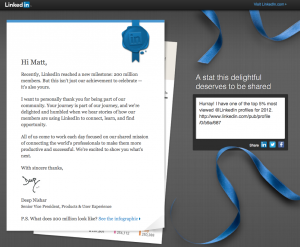Big Numbers Lie – Always
Lessons Learned about Big Numbers
In a phenomenon that is not just peculiar to the digital marketing industry, people love big numbers. Big numbers communicate a sense of accomplishment, movement in the right direction, and that things are “good.”
Context sheds light on big numbers
However, I have learned one important principle during my years in online marketing, and that is that big numbers always lie. They lie because they lack context. The more context added, the more numbers become smaller, more understandable, and then finally: small numbers that tell the true story, and communicate the Why? How? and What? which all enable you to take action.
Those numbers are great, but what’s your ROI?
I learned this principle very early in digital marketing as I was building websites to sell real estate properties in the mid 1990’s. I sold a number of properties based from the leads generated by those websites, and one day I decided to analyze the numbers. Starting out, the numbers were impressive. 95% of my leads were generated from search referrals. The sheer number of search referrals was impressive, and I averaged 20 leads a month from these sites. However, that big number told a boldfaced lie.
When i compared my sales to those leads, I learned a harsh lesson. Not one of those hundreds of leads turned into a sale. Nope, not one.
All of those #1 rankings, high lead conversion rates, tens of thousands of search referrals, impressive visitor numbers, and pages viewed meant nothing because none of my search traffic generated any sales. So where did they come from?
Every sale generated in one year came from a link that I purchased on another website for $25/year. While not generating nearly as impressive numbers compared to search, it was steady, substantial, and the best source of quality leads generated by my website. The return on that investment was one of the best I have ever seen, as the $25/year investment generated over a million dollars in sales.
The LinkedIn Top 5% – Small Numbers Lie, too
Then last week I received an email from LinkedIn. Let me preface the rest of this article: I love LinkedIn. Of all social media, LinkedIn is my favorite.
Now, this email was interesting as it congratulated me on being in the top 5% of LinkedIn profiles. It then asked me to Tweet or Facebook this congratulatory message. I was just about to press Tweet This!, when the analyst in me took over. LinkedIn was also announcing that they hit the 200 million member threshold as well as announcing their top 5% of profiles. SO, on to the maths!
Crunching the numbers
If there are 200 Million members, then 5% of 200,000,000 = 10,000,000. I like the sound of being in the top 5%. But the top 5% is 10 million people. I liked the ego boost initially, but it wore off fairly quickly. To put it in even greater context, the population of the State of Ohio is 11.5 Million. The population of the US is estimated at slightly over 300 Million.
To say it in context, being in the top 5% is exclusive, as exclusive as living in Ohio.
Don’t get me wrong. I love living in Ohio, but I think you see my point.
However, it’s a brilliant campaign
Congrats to you LinkedIn, on a brilliantly conceived and executed marketing campaign. One of the methods of persuading people is to sell the “exclusivity” of the product. LinkedIn, being open to all, found a way to position itself to a finite group of people as being “exclusive.” Then, by positioning itself and offering a great ego boost (seriously, it’s an ego boost) to those members, LinkedIn was then thrust into the conversation on Twitter and Facebook, as millions of users announced their profile as being in the top 5%.
Brilliant. Making others do your link building, announcing and marketing for you. And, what’s even more, they are self-rewarded by doing so.

